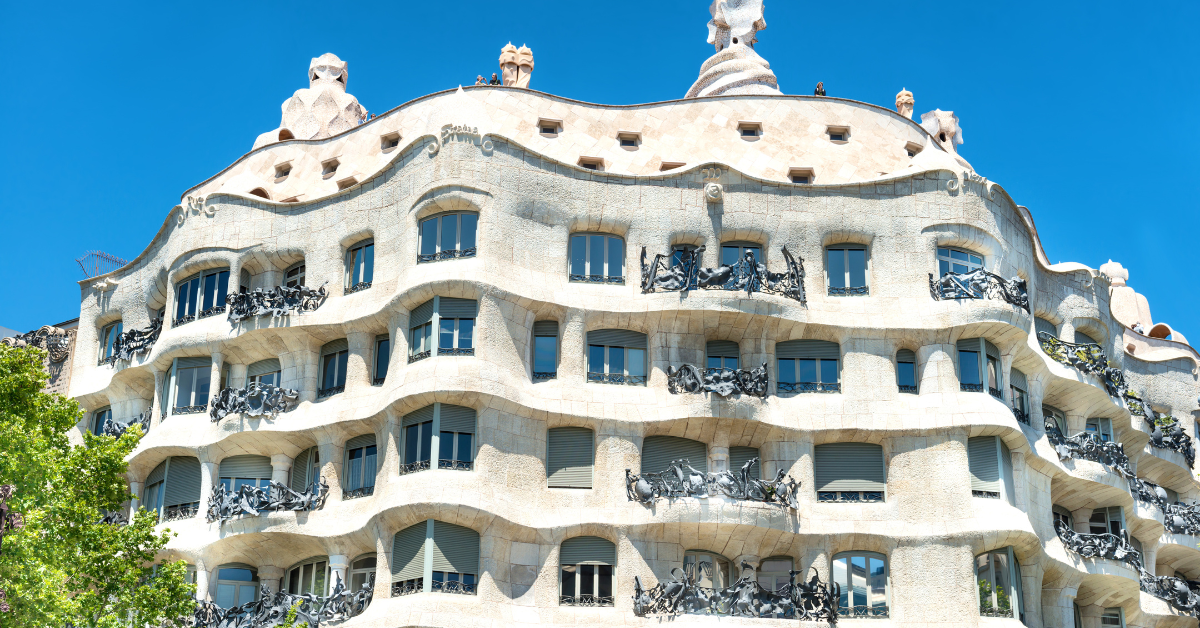In Barcelona, Spain, stands Antoni Gaudí’s masterpiece, Casa Milà. Many fans believe that its flowing curves and organic design inspired the Gyoncord Plaza of Fishman Island in One Piece. This article explores the fascinating parallels between real-world architecture and Oda’s imaginative universe.
What Is Casa Milà?
Built between 1906 and 1912 by the renowned architect Antoni Gaudí, Casa Milà (La Pedrera) is celebrated for its flowing, organic forms and its near-complete rejection of straight lines. Its stone façade appears to ripple like waves, changing with the light and angle of view.
| Item | Detail |
|---|---|
| Architect | Antoni Gaudí |
| Construction Period | 1906–1912 |
| Location | Barcelona, Spain |
| World Heritage Status | Registered in 1984 |
| Features | Curvilinear form, natural light design, sculptural architecture |
Gaudí famously stated that “Nature is the greatest teacher.” Every element of Casa Milà — from its waves of stone to its twisting iron balconies — reflects natural patterns. The building breathes with life, designed to mimic the movement of wind, water, and light.
What Is Gyoncord Plaza in Fishman Island?
Fishman Island, one of One Piece’s most enchanting settings, lies 10,000 meters beneath the sea. At its heart lies Gyoncord Plaza, a gathering place for mermaids and fishmen, surrounded by organic, coral-like architecture that glows beneath the filtered sunlight of the ocean.
| Element | Feature in Fishman Island |
|---|---|
| Architectural Style | Curved, flowing structures |
| Colors | Soft tones reflecting the ocean’s light |
| Illumination | Light filters through seawater, creating a dreamlike glow |
| Motif | Marine life and natural harmony |
The plaza’s design, filled with light and gentle forms, strongly echoes Casa Milà’s organic aesthetic and natural symbolism.
Shared Elements Between Casa Milà and Gyoncord Plaza
Despite belonging to different worlds, the two share remarkably similar design philosophies.
| Aspect | Casa Milà | Gyoncord Plaza |
|---|---|---|
| Structure | Wavelike curves | Flowing, water-like formations |
| Light | Natural light streaming through open courtyards | Sunlight refracted through seawater |
| Texture | Stone and wrought iron | Coral and shell-like motifs |
| Philosophy | Harmony with nature | Coexistence between species and nature |
Gaudí’s guiding belief that “true art imitates the laws of nature” finds a parallel in the Fishman Island’s depiction of harmony and coexistence. Both express a deep reverence for the living world.
The Influence of Gaudí’s Architecture
Gaudí’s works are celebrated as living architecture, combining art, science, and spirituality. His use of organic geometry inspired not only modern architecture but also visual arts, cinema, and animation.
One Piece creator Eiichiro Oda is known for drawing inspiration from diverse cultures and architectural forms. The flowing lines and luminous underwater designs of Fishman Island seem to echo Casa Milà’s distinctive curves.
| Comparison | Gaudí’s Work | Oda’s Storytelling |
|---|---|---|
| Artistic Approach | Recreates nature through structure | Reimagines nature through narrative |
| Use of Light | Creates vitality and motion within buildings | Symbolizes hope and unity under the sea |
| Worldview | Merging humanity and nature | Depicting harmony among species |
Just as Gaudí claimed that “answers lie within nature,” Oda’s fictional world channels the same creative spirit — a vision of unity between living beings and their environment.
A Popular Pilgrimage Site for Fans
Today, Casa Milà has become a “sacred site” for One Piece fans. Visitors are often struck by the sense that they’ve stepped inside Fishman Island itself.
The building changes dramatically throughout the day. Under the Mediterranean sun, it glows with warm vitality; at night, its illuminated curves evoke the quiet mystery of the deep sea.
| Time of Day | Visual Character | Atmosphere |
|---|---|---|
| Day | Sunlight accentuates the curves | Vibrant and full of life |
| Evening | Golden hues wash over the walls | Warm, like a sunset beneath the waves |
| Night | Lighting creates dramatic shadows | Calm and otherworldly, like the ocean depths |
Inside, exhibitions display Gaudí’s sketches and models, revealing his creative process. Fans often find themselves connecting these ideas with One Piece’s themes of imagination and coexistence.
The Message Behind Casa Milà
Throughout his life, Gaudí pursued “harmony between humans and nature.” Casa Milà’s every element — its walls, airflow, and natural lighting — was crafted to embody this ideal.
Similarly, Fishman Island’s story centers on “coexistence between humans and fishmen.” Both Gaudí’s architecture and Oda’s storytelling express the same universal message: the beauty of living together despite differences.
| Theme | Casa Milà | Fishman Island |
|---|---|---|
| Harmony | Human–nature coexistence | Human–fishman coexistence |
| Symbol of Light | Source of life and hope | Hope reaching even the ocean floor |
| Form | Organic, flowing architecture | Living, breathing underwater city |
| Core Message | All life is interconnected | All beings are equal and valuable |
This philosophical overlap explains why so many fans firmly believe in the “Gyoncord Plaza = Casa Milà” theory.
Conclusion
Casa Milà and Fishman Island’s Gyoncord Plaza are united not only by visual resemblance but by a shared philosophy of harmony and respect for life. Gaudí’s pursuit of natural unity and Oda’s vision of peaceful coexistence transcend time and culture, converging through art and imagination.
Casa Milà is not just a building — it is a living work of art. Its movement, light, and structure evoke the same emotional depth found in Fishman Island’s world.
If you ever visit Barcelona, stand before Casa Milà and let its wavelike façade wash over you. You may feel as if you’ve stepped into the oceanic glow of Fishman Island itself. Within its curves lives a timeless message — a shared reverence for nature, creativity, and the boundless imagination of both Gaudí and Eiichiro Oda.






